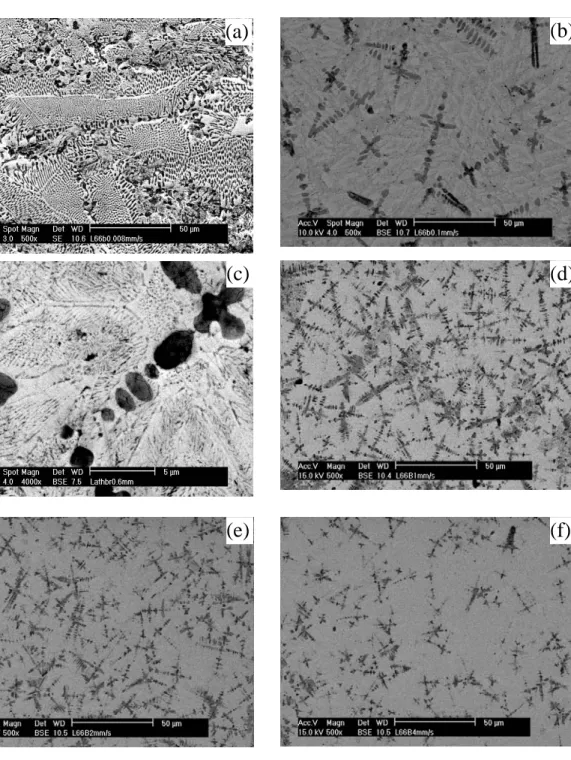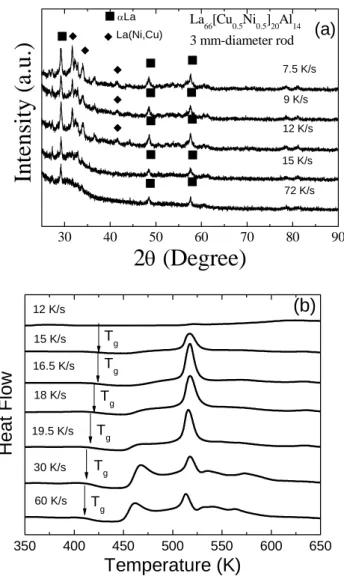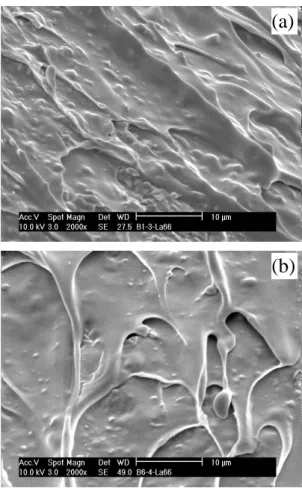Abstract —The microstructure and phase selections of La66Al14(Cu, Ni)20 alloy were studied by Bridgman
solidification and composite materials of dendrites in amorphous matrix or micro- and nano- sized eutectic matrix were formed with different cooling rates. The volume fraction of the dendrite phase reaches a maximum at the cooling rate of about 15 K/s, the secondary dendrite arm spacing λ2 decreases
from 4.3 µm to 0.6 µm with the increasing of cooling rate R and obeys the equation of
λ
2R
0.57=
1
.
74
µm(K/s)0.57. The compression strength, as well as the elastic strain limit of the dendrite/amorphous matrix composite are 600 MPa and 2.3%, respectively. Improved ductility was observed for the dendrite amorphous matrix composites with more dendrite phase by slow cooling rate.Index Terms—Bridgman solidification, bulk metallic glass, eutectic, La-based alloy.
I. INTRODUCTION
OMPOSITE materials with dendrite primary phase embedded in amorphous or nanocrystalline phase matrix usually exhibits improved mechanical properties, e.g. apparent plastic deformation before fracture [1]-[3]. The volume fraction of the dendrite phase (Fd) was usually controlled by changing composition [1],[4]. However, cooling rate during solidification has a significant effect on
Manuscript submitted Nov. 3, 2003. This work was sponsored and supported by Singapore-MIT Alliance.
Y. Zhang, Research Fellow, Advanced Materials for Micro- & Nano-Systems, Singapore-MIT Alliance, National University of Singapore, Singapore (phone: 65-68741301; fax: 65-67752920; email: smazy@nus.edu.sg).
M.L. Lee, Ph. D Student, Advanced Materials for Micro- & Nano-Systems, Singapore-MIT Alliance, National University of Singapore, Singapore (email: smap9046@nus.edu.sg).
H. Tan, Ph. D Student, Department of Materials Science, National University of Singapore, Singapore (email: scip0212@nus.edu.sg).
Q. Jing, Research Fellow, Department of Materials Science, National University of Singapore, Singapore (email: masjq@nus.edu.sg).
Y. Li, Fellow of Singapore-MIT Alliance, also Associate Professor in Department of Material Science, National University of Singapore, Singapore (phone:65-68743348; fax:65-67763604; email: masliy@nus.edu.sg)
.
the phase formation and the resulting microstructure[5]-[7]. Bridgman solidification is a widely used unidirectional solidification method by which the cooling rates can be precisely controlled [8],[9]. In this paper, Bridgman solidification method was used to study the microstructures of La66Al14(Cu,Ni)20 alloy, to obtain dendrite phase reinforced metallic amorphous matrix or micro- and nano- sized eutectic matrix composites.
II. EXPERIMENTAL PROCEDURES
The ingots were prepared by arc-melting a mixture of pure La (99.9%), Al (99.9%), Ni (99.98%) and Cu (99.999%) in an argon atmosphere. The composition, La66Al14(Cu, Ni)20, is nominally expressed in atomic percent and the alloys. Each master ingot was firstly melted five times, then crushed and remelted four times. Bridgman solidifications were carried out by inductive melting the alloys in vacuum sealed quartz tubes with 3 mm internal diameter and a wall thickness of 1 mm. It involved remelting prior to steady withdrawal at constant pre-determined velocity (V) in the range of 0.008-4.82 mm/s through a temperature gradient (G) of 15 K/mm into a water bath. The cooling rate (R) can be calculated as [8],[9]:
V
G
R
=
⋅
(1) Then the rod samples with 3 mm diameter were mounted and polished for observation under a scanning electron microscope (SEM) and optical microscopy (OM). The degree of amorphicity of all samples was examined by a X-ray diffraction (XRD, with Cu Kα radiation) and differential scanning calorimetry (DSC). The DSC was performed with a heating rate of 40 K/min.The compressive tests were performed by an Instron-5500R mechanical machine. The cylindrical samples with diameters of 3 mm and length of 6 mm was cut by diamond cutter, the ends of the specimens, were mechanically polished. For each type of samples, 3 to 4 specimens were tested. Strain gauges (Gauge type is FLA-05-11) were attached to the surface of the specimens to measure the
Effect of Microstructure Changes on
Mechanical Properties of La
66
Al
14
(Cu, Ni)
20
Amorphous and Crystalline Alloys
Yong Zhang, Irene Mei-Ling Lee, Hao Tan
*, Qin Jing
*, Yi Li
AMM&NS, Singapore-MIT Alliance, National University of Singapore, Singapore 117576
*Department of Materials Science, National University of Singapore, Singapore 119260
Fig. 1 Morphologies of samples cooled by 0.12 K/s, fully eutectic (a); 1.5 K/s, eutectic+dendrite (b); 9 K/s, eutectic+dendrite (c); 15 K/s, dendrite+amorphous (d); 30 K/s, dendrite+amorphous (e); and 60 K/s, dendrite+amorphous (f).
(a)
(b)
(c)
(d)
local deformation. Compressions were conducted using constant crosshead velocity of 0.06 mm/min. The resulting strain rate is 1.67 ×10-4 sec-1.
III. RESULTS AND DISCUSSION
A. Microstructure Selections
Fig. 1 shows the morphologies of samples obtained under different cooling rates. When the cooling rate is very low (0.12 K/s), the morphology is fully eutectic, Fig. 1(a). However, as the cooling rate increases, dendrite plus eutectic (Fig. 1 (b) and (c)) or dendrite plus amorphous (Fig. 1 (d)-(f)) can be observed. This alloy has been previously verified as a pseudo ternary eutectic by studying the heating and cooling curves in a DTA cell [10]. The phenomenon that eutectic alloy exhibits eutectic morphology at slow cooling rates but shows off-eutectic morphology (dendrite+eutectic) at increased cooling rate, has been observed in Al-Si binary alloy, this is in accordance with the skewed eutectic coupled zone theory [7],[10]. The volume fraction Fd and the secondary arm-spacing λ2 of the dendrite phase as functions of cooling rate R were plotted in Fig. 2.
0 1 2 3 4 5 -2 -1 0 1 2 3 16 24 32 40
Ln
λ
2F
dLnR
Fig. 2. Volume fraction Fd ( , %) and secondary arm-spacing λ2 (O, µm)
of the dendrites as functions of the cooling rate R (K/s).
The Fd first increases with the increase of cooling rate
and reaches a maximum of 35% at the cooling rate of 15 K/s and then decreases slowly with the increasing of the cooling rate, similar result was also observed in Pd-based alloy [9]. This is because the growth of dendrite is a competitive process with growth of the eutectic and the formation of amorphous [10]. When the cooling rate is low, more eutectic may form and when the cooling rate is high, more glass will form. Fig. 2 also shows that λ2 decreases with the increasing of cooling rate and the correlation between λ2 and cooling rate R can be expressed by the equation:
LnR
Ln
λ
2=
1
.
74
−
0
.
57
(2) and then:74
.
1
57 . 0 2R
=
λ
µm(K/s)0.57 (3) as R=GV, G=15 K/mm, thus the equation can also be expressed by:06
.
19
57 . 0 2V
=
λ
µm1.57/s0.5 (4) The above equation is very close to the prediction by Jackson-Hunt model, where 21 2
V
λ
=constant [11]. The secondary dendrite arm spacing of Pd dendrite in Pd-based alloys was reported to obey 31 2
V
λ
=constant [9]. 30 40 50 60 70 80 90 La(Ni,Cu) αLa J J J J J J J J J J J J La 66[Cu0.5Ni0.5]20Al14 3 mm-diameter rod 7.5 K/s 9 K/s 12 K/s 15 K/s 72 K/sIn
te
nsi
ty (a
.u
.)
2
θ
(Degree)
(a)
350 400 450 500 550 600 650 Tg Tg Tg Tg TgHeat Flow
Temperature (K)
60 K/s 30 K/s 19.5 K/s 18 K/s 16.5 K/s 15 K/s 12 K/s Tg(b)
Fig. 3. XRD patterns for the L66 alloys prepared by Bridgman solidifications (a);DSC heating curves of L66 alloys (b).
Fig. 3 (a) shows the XRD patterns for the samples obtained at different cooling rates. For the samples cooled by 15 K/s and 72 K/s, XRD patterns show crystalline peaks superimposed on an amorphous maximum, which indicates that these samples are composite of crystalline and amorphous. The crystalline phase was identified as α-La
[12] and it exhibits dendritic shape from the SEM observations, as shown in Fig. 1 (d)-(f). When the cooling rate is below 12 K/s, only crystalline peaks can be observed. This indicates that these samples have been fully crystallized. Their corresponding DSC heating curves are shown in Fig. 3 (b). Samples prepared by cooling rate of above 15 K/s exhibit distinct glass transitions and crystallization events, which indicates that these samples contain a significant amount of amorphous phase. This is in good agreement with the XRD and SEM results shown before. Fig. 3 (b) also shows clearly that the glass transition temperature Tg is almost constant, around 425 K and the crystallization event includes a primary crystallization followed by a secondary crystallization for the samples cooled by 60 K/s and 30 K/s. When the cooling rate is above 19.5 K/s and below 15 K/s, the primary crystallization peak is diminished. This causes the Tx become much higher, thus, ∆Tx, which is defined as the interval between the Tx and Tg, is larger for these samples than those obtained under high cooling rates. No crystallization peak was observed for the sample with cooling rates of below 12 K/s, which indicates that no amorphous was formed within these samples. This agrees well with the XRD result and SEM observations.
B. Compressive properties 0.0 0.5 1.0 1.5 2.0 2.5 3.0 3.5 4.0 4.5 5.0 0 100 200 300 400 500 600 700 800
C
o
mpre
sive
Stres
s
(MP
a
)
Strain (%)
15 K/s 60 K/s 0.4 %Fig. 4. Stress-Strain curves for dendrite-glass composites cooled by 15 K/s and 60 K/s.
Compression tests were performed on the dendrite-glass composite prepared by the cooling rates from 15 to 60 K/s. Fig. 4 shows the typical stress-strain curves of compression tests. No obvious differences in the compressive strength and modulus were observed for these two specimens cooled by 15 K/s and 60 K/s. The compressive strength of these specimens is about 600 MPa. No plastic deformation was found for the specimens by the cooling rate of 60 K/s, while a small amount of plastic deformation (about 0.4 %) can be found for the specimen cooled by 15 K/s. The measured
volume fractions of dendrite La phase are 35% and 28% for the cooling rate of 15 K/s and 60 K/s, respectively. The poor plasticity of the specimen cooled by 60 K/s may be due to the volume fraction of the dendrite phase is too low. This amount of dendrites cannot effectively hinder the propagation of shear bands [1], [2].
Fig. 5. Fracture surfaces of specimens cooled by 15 K/s (a) and 60 K/s (b).
Fig. 5 shows the fracture surfaces of specimens cooled by 15 K/s (a) and 60 K/s (b). Both of the fracture surfaces exhibit vein-like patterns. Fracture surface melting was also observed. These phenomena are also reported by other researchers [13],[14].
IV. CONCLUSIONS
Composite materials with dendrite phase embedded in amorphous matrix and eutectic matrix were obtained by Bridgman solidification in La66Al14(Cu,Ni)20 alloy. The volume fraction of the dendrite phase reaches a maximum at the cooling rate of 15 K/s and the secondary dendrite arm spacing obeys the relation of
λ
2R
0.57=Constant. The compression property is very sensitive to the volume fraction of the dendritic phase. Fracture surface melting was observed.(a)
ACKNOWLEDGMENT
Y. Zhang thanks the help from Dr. Dong Ma and Dr. Wei Xu.
REFERENCES
[1] F. Szuecs, C. P. Kim, and W. L. Johnson, “Mechanical properties of Zr56.2Ti13.8Nb5.0Cu6.9Ni5.6Be12.5 ductile phase reinforced bulk
metallic glass composite,” Acta Mater., vol. 49, no. 9, pp. 1507-1513, May 2001.
[2] J. Eckert, U. Kühn, N. Mattern, G He, and A. Gebert, “Structural bulk metallic glasses with different length-scale of constituent phases,” Intermetallics, vol. 10, no. 11-12, pp. 1183-1190, Nov.-Dec. 2002.
[3] G. He, J. Eckert, W. Löser, and L. Schultz, “Novel Ti-base nanostructure-dendrite composite with enhanced plasticity,” Nature Mater., vol. 2, no. 1, pp. 33-37, Jan. 2003.
[4] L. Q. Xing, Y. Li, K.T. Ramesh, J. Li, and T.C. Hufnagel, “Enhanced plastic strain in Zr-based bulk amorphous alloys,” Phys. Rev. B vol. 64, no. 18, pp. 180201-4, Nov. 2001.
[5] W. Kurz and D. J. Fisher, Int. Metals Rev., vol 5-6, pp. 177, 1979. [6] D. J. Fisher and W. Kurz, Acta Metall., vol. 28, pp. 777, 1980. [7] M. C. Flemmings, Solidification Processing, New York:
McGraw-Hill, 1974. pp. 146.
[8] D. Ma, Y. Li, S. C. Ng, and H. Jones, “Unidirectional solidification of Zn-rich Zn-Cu peritectic alloys - II. Microstructural length scales,” Acta Mater., vol. 48, no. 8, pp. 1741-1751, May 2000. [9] X. Hu, S. C. Ng, Y. P. Feng, and Y. Li, “Glass forming ability and
in-situ composite formation in Pd- based bulk metallic glasses,” Acta Mater., vol. 51, no. 2, pp. 561-572, Jan. 2003.
[10] H. Tan, Y. Zhang, D. Ma, Y. P. Feng, and Y. Li, “Optimum glass formation at off-eutectic composition and its relation to skewed eutectic coupled zone in the La based La-Al-(Cu,Ni) pseudo ternary system,” Acta Mater., vol. 51, no. 15, pp. 4551-4561, Sep. 2003. [11] K. A. Jackson and J. D. Hunt, Trans. Metall. Soc. A.I.M.E. vol. 236,
pp. 1129, 1966.
[12] H. Tan, Y. Zhang, Y. P. Feng, and Y. Li, “Synthesis of La-based in-situ bulk metallic glass matrix composite,” Intermetallics, vol. 10, no. 11-12, pp. 1203-1205, Nov.-Dec. 2002.
[13] Z. F. Zhang, G. He, J. Eckert, and L. Schultz, “Fracture mechanisms in bulk metallic glassy materials,” Phys. Rev. Lett., vol. 91, no. 4, pp. 045505-4, Jul. 2003.
[14] C. T. Liu, L. Healtherly, D. S. Easton, C. A. Carmichael, J. H. Schneibel, C. H. Chen, J. L. Wright, M. H. Yoo, J. A. Horton, and A. Inoue, “Test environments and mechanical properties of Zr-base bulk amorphous alloys,” Metall. Mater. Trans. A, vol. 29, no. 7, pp. 1811-1820, Jul. 1998.
Yong Zhang was born in HeBei Province, China, on Jun. 26, 1969. Doctor Degree, State Key Lab. for Advanced Metals & Materials, University of Science & Technology Beijing, China, 1998; Master Degree, Materials Science & Engineering Department, University of Science & Technology Beijing, China, 1994. Bachelor Degree, YanShan University, China, 1991. Yong’s research work is on formation and properties of bulk metallic glasses and bulk metallic glass matrix composites.


